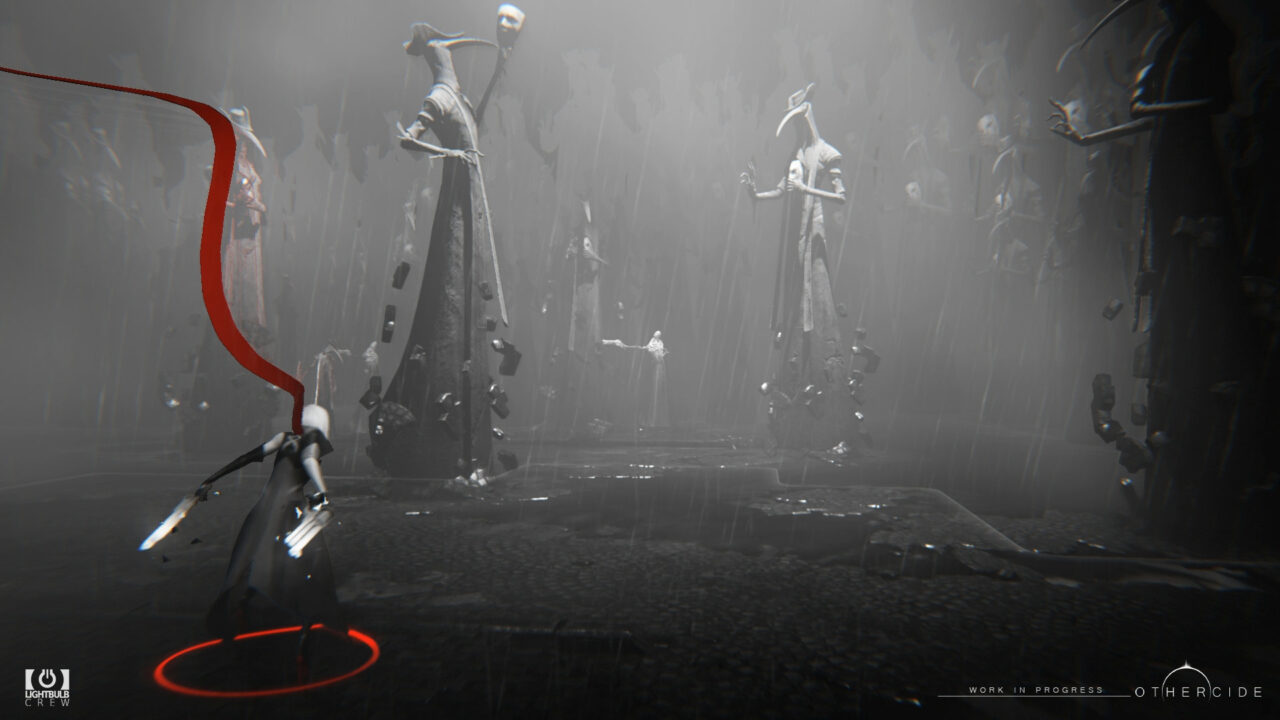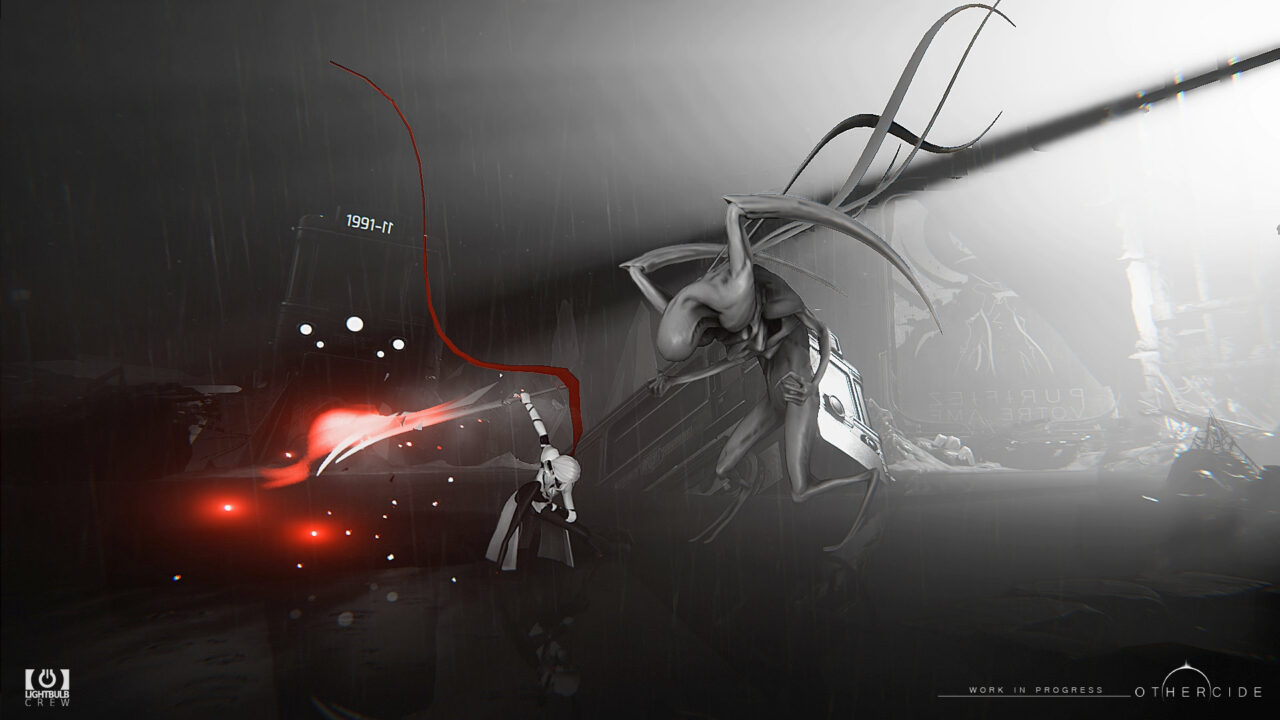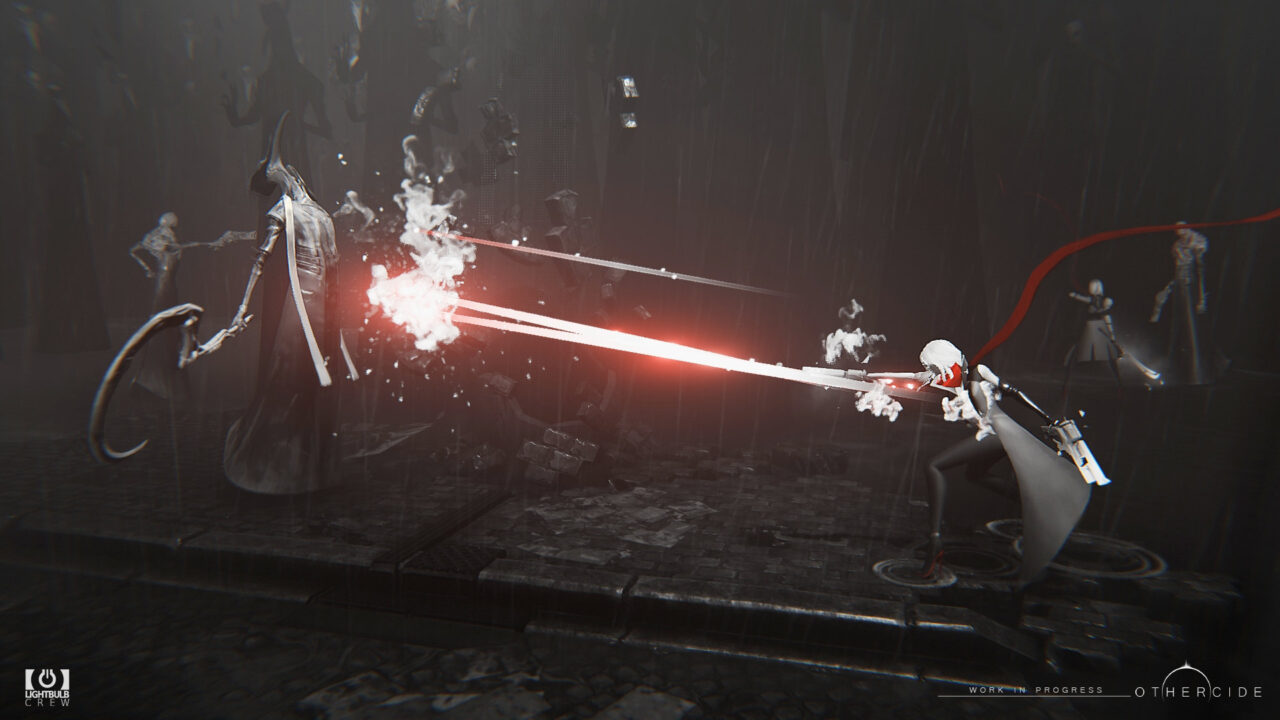In the vast majority of games, failure is the end of the journey. We’re met with Game Over screens filled with sombre music while our cursors hover over the option to try again, load our last save, or quit to the main menu. In Othercide, failure is a core mechanic. Rather than an abrupt end to the story, it is a continuation of a tale told across numerous attempts that end in bloody defeat. In fact, Othercide‘s opening moments have the player fall in battle against impossible odds, offering just a glimpse of the grim future ahead.
Othercide is essentially one part horror, one part roguelike, and one part tactical RPG. The player fights against the terrors of the unknown as Daughters — remnants and pieces of the game’s primary protagonist, known only as The Mother. Across various missions, Daughters will gain experience in battle, learn new abilities as they grow, and unlock memories of the past to augment said abilities. Should mistakes turn into maladies or strength be insufficient, players are kicked back to the beginning of the game with a handful of boosts at their disposal… as long as enough currency has been accumulated.
Bound to its roguelike blood, Othercide is broken down into runs known as “recollections.” Each recollection is a restart with information from the future sent back in time, so you’re able to face the terrors before you with newfound knowledge. Every recollection is broken down into five eras, each with a boss that can be engaged early if the player wishes. Stacking the aforementioned boosts — known as “Remembrances” — from prior runs will offer numerous bonuses to make each journey just a little bit easier. Remembrances will grant the player extra damage to enemies based on the number they’ve killed, allow Daughters to be resurrected, or even skip entire eras to get back into the fight more quickly.
Battles unfold in a tactical grid-based fashion with Action Points (AP) as the main resource for attack and movement. A dynamic timeline dictates which units will go when, though it can be manipulated with ease. Mastering the timeline is crucial and can turn the tide of battle. While combat is turn based, it’s still incredibly oppressive, brutal, and true to its horror roots. Enemies may rush, teleport, or leap great distances to close the gap. Every hit from the enemy packs an even heavier punch than most games, as the HP lost cannot be recovered. Othercide has no way to restore your HP other than sacrificing another daughter of equal or higher level. This can lead to a hard-fought series of battles which leave your army in tatters and may force you to make rather difficult decisions.

With progression based around missions, scenario variety is somewhat lacking: hunt missions taking up the vast majority of encounters available. With the number of hunts that populate the list each day, the basic gameplay loop of Othercide can become quite repetitive. This is more pronounced after failing against a boss and having to resurrect your Daughters. Whether newly created or brought back from the dead, Daughters can equip “Memories” to their skills that give them boosts such as enemy delays, increased damage, shielding, and more. These memories are temporary, as they’ll be lost at the start of a new recollection regardless of how it was ended. Skills, however are permanent, leading to some possibly botched builds if the player decides to pick new skills carelessly.
The main thing which stands out about Othercide is its aesthetic. The black, white, and red accent color scheme is one of my favorite art styles, and I was certainly delighted to see it flourish in motion. Flowing red scarves float about while Daughters clad in black and white dash across ruined streets and dilapidated wooden floors, leaving little streaks of red as they cross the battlefield. When blood is shed, it stains the ground, adding just a little touch of life to a dead environment. The character designs are dripping with style and finesse as Daughters wield pistols, spears, shields, oversized swords, and massive scythes. As battles rage on, damage taken is also reflected in the Daughter’s physical appearance. Blood may soak their body, garments may be frayed and slashed, and a tinge of corruption may color their faces as they cut through each brutal encounter.
The horrors your army faces are equally as impressive. Mad masked cultists and nightmarish, wrong approximations of the human form make up the majority of enemies. Gruesome aberrations stumble along the map absent any sense of grace. The bosses easily steal the show with their intricately detailed and monstrously large presence looming in the background of each era as a taste of things to come should you survive the onslaught before you. While the battlefields can look somewhat similar due to the aesthetic, the maps have plenty of character thrown in to fit the era’s theme. The city maps have collapsed buildings, ruptured water lines, and metro tunnels while the church maps have scattered pews and a concerning number of candles and single-subject portraits littered about. Each map is tailored to the era. What’s more, simply rotating the right stick will give the player a glance at the rest of the area, which may be flooded by myriad nightmare creatures simply observing your battle from a safe distance.
Aurally, Othercide sounds generally fantastic sans a few ill-fitting tracks. Much of the soundtrack is a gloomy collection of strings and piano that feels reminiscent of Bloodborne on numerous occasions. I feel it’s a perfect fit. Conversely, there are a handful of vocal tracks laden with heavy guitar and some symphonic touches that sound like early 2000s nu-metal and gothic rock. Unfortunately, some of these songs play in boss fights that can be five- to twenty- minute affairs in some instances. They looped repeatedly and dug their way into my, head much to my chagrin.
Despite a few faults with the soundtrack, the sound design itself is great. Revolvers pack a powerful punch with each shot, and blades swung deftly sound like they’re cutting cleanly through the flesh of foes. Enemies with more limbs than they should ever have give off sickening, albeit fitting, crunches and slaps as they scurry and scamper across the screen. Every attack feels like it has an appropriate weight to it, and the anguished screams of the nightmare creatures rushing at you sound as terrifying as the creatures look. The sounds can be disturbing and are right at home with the horror themes and aesthetic of the game.

While appropriate to the themes of failure and memory, the game’s narrative is slightly muddled and messy in how it’s handled. The story is told non-chronologically through a series of memories that are randomized tiered drops from enemies. This leads to a bit of RNG when trying to unlock both the story and the previously mentioned Remembrances for future runs. Remembrances hold almost all of the lore within the game, leading hundreds of years back into the protagonist’s history. Additionally, loading screens may share a bit of deeper lore regarding the world and mythos, but those too are generally randomized. It’s evocative of how Souls games handle their overall mythos and lore.
I swayed back and forth between loving the game and being fed up with it throughout my playthrough. The roguelike nature adds a challenge, but each run doesn’t feel overly distinct due to the revival mechanic. One other glaring issue is an inflated and continually growing enemy count. Some encounters involved 18 or more enemies, though only a handful are on screen at any given time. I felt myself worn down from slogging through walls of reinforcements over and over. This is an issue I’ve had with many tactical RPGs over the years, but it seems developers in this sub-genre believe “more enemies” is the first answer to the question of how to challenge the player.
Outside of standard encounters, there is a touch of brilliance in each boss encounter to show what is possible if you devote a bit of time to studying and theory-crafting your builds. There were many times I struggled in vain against a boss only to have them wipe the floor with me. I studied them on follow-up attempts, asking myself what they could do that I couldn’t. With the games memory system and skills, you can do practically everything a boss does, but better. Things I had previously lamented as unfair were now my primary weapon against my foes. The feeling of shutting down a boss before it even has a chance to act after hours of struggle is simply exhilarating.

My time with Othercide was somewhat turbulent but remained highly enjoyable in the long run. There were many moments where I wanted to give up and not bother, but the game kept haunting my mind when I wasn’t playing it. I’d sit at work wondering if it’s better to go with 60% damage boost memories or should stack 35% weakness on an enemy. Should I go with buffs to force counters with added delays? I’d written out flow charts on paper on how to deal with bosses and spent far too many hours theory-crafting builds and putting together a hitlist of memories I want to obtain. Even when I wanted to toss the game and found myself groaning while trudging through another recollection after getting my face kicked in, Othercide was incredibly difficult to put down, let alone stop thinking about.
The game stands out among the crowd with its immediately eye-catching aesthetic and its roguelike mixture of tactics and horror. It’s an oppressive game that teaches the player through repeated failure, granting new insight to use in future encounters. The game’s mechanics may seem simple, but there is a beautifully crafted battle system with all the tools needed to beat the nightmarish enemies and bosses at their own game. While the roguelike elements add in some repetition and grind, I highly recommend Othercide to tactics fans looking for something different. If given proper time and attention, Othercide is an incredibly rewarding tactical RPG that will push players to their limits. It’s difficult and frustrating at times, but it all pays off in the end.


